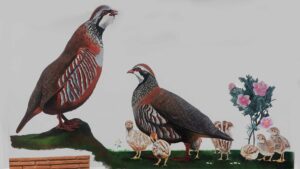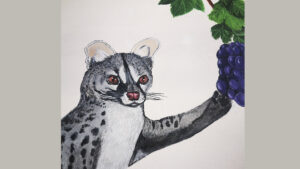11. The Warblers
Discover small but beautiful birds
Six different species of warbler on a hawthorn tree
About these Birds
Some curiosities about these birds
Warblers are small birds of the passerine group whose defining characteristic is the presence of three toes forward and one backward. These small birds of the Syilviidae family are quite small and thrive in thickets and wooded areas where they like to move from branch to branch looking for food, ranging from insects to cultivated fruits, wild fruits and berries, as shown in this painting.
The warblers show a notable sexual dimorphism, with the males being more striking, with contrasting colours and notable features such as the red rim of the eye and the plumage differentiated between the two sexes. The specimens illustrated in this mural are all males.
From left to right we have the following species: Sardinian Warbler, blackcap, subalpine warbler, spectacled warbler, western Orphean warbler and the long tailed warbler.
Sardinian Warbler (Sylvia melanocephala) is found in shrubby areas and can also be found in pine forests and anthropised areas. It likes orchards, breeding begins in March and finishes in July, and therefore usually lays two clutches, eats insects and complements them in autumn with berries. It can be distinguished by the dark colour of its head and eye with a deep red rim in males, while females are brown.
The blackcap (Sylvia atricapilla) is a permanent species on the Iberian Peninsula, and likes to occupy wooded areas where it feeds on insects and strawberries. The male is grey with a dark hood, while the female is brown with a brown hood.
Subalpine warbler (Sylvia cantillans) is the most colourful of all, with a reddish breast and plumage and a red eye rim, distinguished by the white mark under the bill. It is a migrant in Spain, and complements its diet of insects with berries, the females being much more cryptic than the males.
The Spectacled Warbler (Sylvia conspicillata) has a grey head and mantle, white eye-ring and throat and a brown belly. The song of the tomato warbler is very special, with repetitive and melodious sounds that change during the mating season. They like to occupy open areas with low-growing shrubs, and thyme groves are one of their favourites, hence their name.
The western Orphean warbler (Sylvia hortensis) is the largest of all the warblers in terms of size, characterised by a robust beak, dark colours on the head and light on the throat and belly, its whitish-yellow eye is one of its distinguishing features. The female’s mask is much less dark than that of the males. It likes sparsely wooded areas, is a migrant and spends the months of April to July in our country. Its song is reminiscent of a cicada.
The long tailed warbler (Sylvia undata) is the smallest of all the warblers and shows marked sexual dimorphism. The male has a beautiful greyish blue head and back with a light-coloured throat finely speckled with white dots, and a greyish belly. The female has the same colours, but much duller. The female has the same colours, but much duller, and its common name is that it has a very long tail, which is usually held upwards in a very characteristic warbler pose.
Warblers are very difficult to see in the wild, restless birds that test the patience of the observer, but which, once discovered, are a delight for all the senses. Due to their small size, they are very sensitive to sudden changes in temperature, being very affected by drops in the thermometer, which can cost them their lives in many cases.
They are perched on a hawthorn (Crataegus monogyna), a shrub that flowers from April to June, the fruits or majoletas have vitamin C and offer a nutritional complement to many species in forests and bush areas.
How it was done
Discover how this Painting was made
It is a painting that was carried out over a month, with a cumulative duration of 56 hours, most of the time being spent on the realisation of the intricately structured perch. The colour contrast offered by this mural illustration is one of the most outstanding details. It is made of acrylic and measures more than 3 metres in length.
ROUTE OF PAINTINGS
The Painting Route through Vélez-Blanco continues
This painting is located on the façade of a resident of Vélez Blanco, it is next to a door and its dimensions are 3.56 m wide and 1.60 m tall. You can see other works by following our street route in Vélez Blanco.
BOOKINGS
Book your exclusive stay at The House of the Birds
You will discover a different kind of rural accommodation, with all the comforts of a completely restored house but with a rural feel. With fireplace, wine cellar, games room, table football room, spacious lounge, comfortable bathrooms, fully equipped kitchen and in the heart of a unique village with its beauty as is Vélez Blanco.



